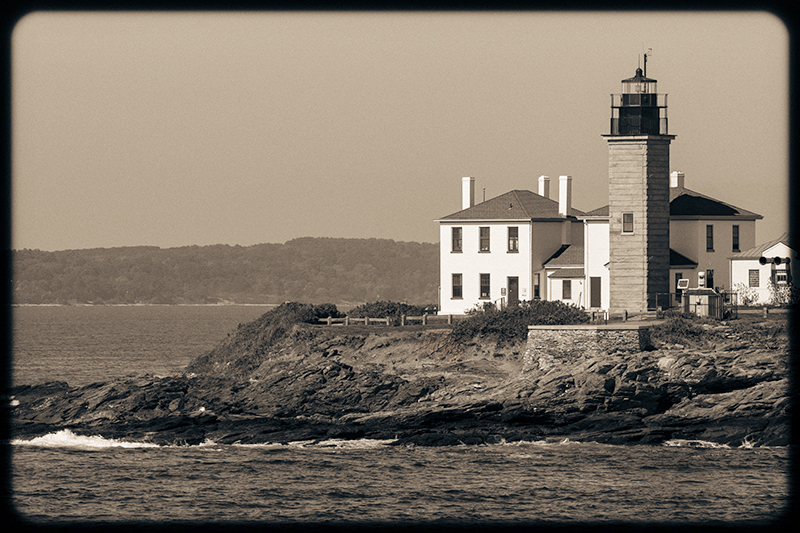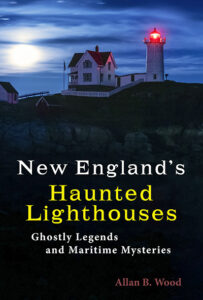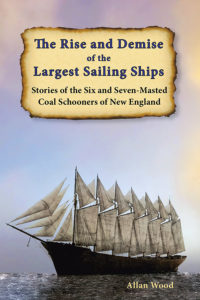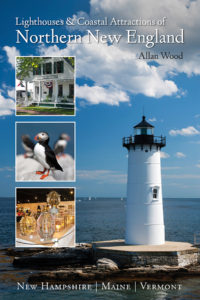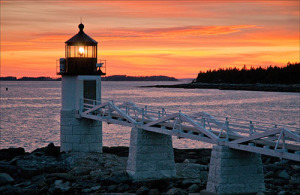Tragedy at Two Rhode Island Lighthouses
Caused by New England’s Worst Hurricane in 1938
On September 21, 1938, one of the most destructive hurricanes in recorded history struck Long Island and Southern New England. It was only supposed to be a breezy fall day in New England, but the track started surprisingly barreling up the coast. The storm hit Long Island and southern Connecticut on September 21 with sustained hurricane-force winds of 121 miles per hour and a maximum recorded wind gust of 186 mph, the highest ever recorded. It produced three to seven inches of rainfall.
Rhode Island got the worst of it. The storm surge of 12 to 15 feet destroyed most coastal homes, yacht clubs, and marinas on Narragansett Bay. More than 63,000 people lost their homes. Almost 20,000 public and private buildings were destroyed, and 100 bridges had to be rebuilt. Nearly 700 people died in the storm (682), and damages came to over $300 million at that time, equivalent to almost 5 billion dollars today. Rhode Island also mourned tragedies from this destruction that struck two lighthouses on Narragansett Bay from the storm at Prudence Island (Sandy Point) Light and Beavertail Light.
Tragedy at Sandy Point (Prudence Island) Lighthouse
As shipping, whaling, and trade grew, along with tourism to the area, petitions were made for a lighthouse to guide mariners away from the dangerous shoals offshore and along Sandy Point on Prudence Island. In 1852, the existing lighthouse at Goat Island in Newport Harbor was dismantled and moved to Prudence Island, which became the current Prudence Island Lighthouse. It had a wooden keeper’s dwelling built near the light.
On September 21, 1938, with hardly any warning, New England’s worst hurricane caused massive wind gusts and a huge tidal wave to come up Narragansett Bay, destroying everything in its path. Three guests had arrived beforehand to visit Keeper George Gustavus at Prudence Island (Sandy Point) lighthouse. They were former keeper Martin Thompson, James Lynch, and Lynch’s wife, Ellen. Gustavus’ wife, Mabel, and their youngest son of ten children, Eddie, were also at the house. The keeper’s two young daughters were still at school when the storm struck.
As the winds continued to increase, all six took refuge on the second floor of the keeper’s building, where former keeper Martin Thomson persuaded everyone that the structure was sturdy enough to survive the storm. The keeper’s instincts turned out to be incorrect. The massive storm surge raised the water levels so high that ferocious waves crashing into the building caused the structure to break apart. All six occupants were swept under the tidal wave. Keeper Gustavus was swept back to shore about a half mile from the lighthouse and miraculously made it to safety with the help of 18-year-old George Taber, a local islander who saw the keeper near the shoreline. Gustavus learned soon afterward, much to his horror, that his wife, son, and their three guests had perished in the storm. His other children had survived the incident. Only the lighthouse tower survived the hurricane.
Keeper’s Worst Nightmare Comes True at Beavertail Light
Beavertail is the third oldest lighthouse in America, located at the southern tip of Conanicut Island, on Narragansett Bay, facing the open seas. Near the current Beavertail Lighthouse, Beavertail Point had a watchhouse constructed in 1705 by the early settlers. It was then developed into a fire-lighted beacon that was tended by the local Indians in 1712. The first government-funded lighthouse consisted of a 69-foot wooden tower, which used fire as a light source and was erected in 1749. The tower burned down in 1753, and a new one was built about 100 feet from the original location, this time made of brick and stone.
During the unsuspected tidal wave caused by the unknown hurricane of 1938, Keeper Carl Chellis of Beavertail Lighthouse was trying his best to protect the beacon as it was being battered around from the storm surge, and where the lighthouse faced the open waters, rocks, and debris were flying everywhere from the destructive winds. The hurricane damaged most of the buildings at Beavertail and exposed the foundation of the original 1749 tower, which is 100 feet from the new tower.
Meanwhile, Assistant Keeper Edward A. Donahue threw himself into the ocean to escape the engine room, which was collapsing around him, believing “it was the easiest way to die.” Donahue’s son saw his father just in time to jump into the raging waters to try to save his father, and both were eventually able to swim back to shore and find shelter.
As the storm was coming upon the region without warning, school officials closed the schools that day, feeling the children would be safer in their homes. The local school bus carrying Keeper Carl Chellis’s son and daughter was heading towards the lighthouse when they were blocked by a car pitched across the road. The bus driver, Norman Caswell, fearing he and the seven children he was transporting would drown if they stayed on the bus, tried to bring the kids to higher ground. As they all got out of the bus, the tidal storm surge hit and swept six of the helpless children away with the bus, drowning all except the keeper’s son and Caswell himself. Caswell fell into shock after watching the children perish.
It was hours later when Keeper Chellis had nearly escaped with his own life as he watched Beavertail Lighthouse nearly become destroyed by this destructive storm. Still, he also had to receive the horrible news that his daughter had also drowned by the tidal wave sweeping over the school bus.
Caswell died shortly after the incident, overcome with guilt and unable to cope with the deaths of the children. Keeper Chellis would perish seven years later on a tour of duty in the Pacific during WWII. Assistant Keeper Edward Donahue remained at Beavertail until he died in 1953 after over 40 years in the Lighthouse Service and Coast Guard.
In the “wind that shook the world,” as it was later called, New England lost more than 25 percent of its cherished elms, and over half a million property deeds had to be resurveyed because of severe storm damage. In New Hampshire alone, one and a half billion board feet of timber were knocked down; “storm” lumber recovery would take years. When war broke out in Europe, much of the lumber was used to build military barracks and the interiors of transport ships.
New England has never experienced as much destruction as this storm. Plenty of warnings would have been provided with today’s technology, so this scope of tragedy and destruction should never be replicated on such a massive scale again.
Exploring Prudence Island Light and Beavertail Light
Visitors will find little evidence of the destructive force that engulfed this region over 85 years ago.
Prudence Island is a quiet island that measures about 7 miles long and 1 1/2 miles wide, with tracts of land maintained by various conservationist organizations consisting of land primarily owned by the Rhode Island State Park Department, Audubon Society, and various private foundations. There are no public bathrooms unless you find something available at the dock. The main beach is quiet all year round and is about 1 1/2 miles long. There are two general stores on the island.
The island is accessible by boat or the Bristol – Prudence Island Ferry. It’s a mile walk to the lighthouse (bring plenty of bug repellent). Here are some photos of Prudence Island Light.
Beavertail lighthouse, the third oldest beacon in the United States, is a popular attraction for many visitors to the state. It is located in Beavertail State Park at the end of Beavertail Road, at the southern tip of Conanicut Island, Narragansett Bay. There is also a museum to explore and unique rock formations many tourists enjoy. The park is a good size for plenty of outdoor activities and places to escape and enjoy the quiet.
Nearby, Newport is Rhode Island’s main vacation playground for tourists to visit and explore while they’re in the area. This region provides some of the best sailing around Narragansett Bay and offers tourists plenty of boat tours, excursions, and events. Visit some of the famous elaborate mansions.
Here are some photos of Beavertail Light.
Books to Explore
New England’s Haunted Lighthouses:
Ghostly Legends and Maritime Mysteries
Discover the mysteries of the haunted lighthouses of New England! Uncover ghostly tales of lingering keepers, victims of misfortune or local shipwrecks, lost souls, ghost ships, and more. Many of these accounts begin with actual historical events that later lead to unexplained incidents.
Immerse yourself in the tales associated with these iconic beacons!
The Rise and Demise of the Largest Sailing Ships:
Stories of the Six and Seven-Masted Coal Schooners of New England.
In the early 1900s, New England shipbuilders constructed the world’s largest sailing ships amid social and political reforms. These giants were the ten original six-masted coal schooners and one colossal seven-masted vessel, built to carry massive quantities of coal and building supplies and measured longer than a football field! This self-published book, balanced with plenty of color and vintage images, showcases the historical accounts that followed these mighty ships.
Available also from bookstores in paperback, hardcover, and as an eBook for all devices.

Book – Lighthouses and Coastal Attractions in Southern New England: Connecticut, Rhode Island, Massachusetts
Lighthouses and Coastal Attractions of Southern New England:
Connecticut, Rhode Island, and Massachusetts.
This 300-page book provides memorable human interest stories from each of the 92 lighthouses, including stories about the Hurricane of 1938 that entered Narragansett Bay in Rhode Island. You can explore plenty of indoor and outdoor coastal attractions, including whale-watching excursions, lighthouse tours, windjammer sailing tours, parks, museums, and even lighthouses where you can stay overnight. You’ll also find plenty of stories of hauntings around lighthouses.
Lighthouses and Coastal Attractions of Northern New England:
New Hampshire, Maine, and Vermont.
This 300-page book provides memorable human interest stories from each of the 76 lighthouses. It also describes and provides contact info for plenty of indoor and outdoor coastal attractions and tours. These include whale watching, lighthouse tours, unique parks, museums, and lighthouses where you can stay overnight. There are also stories of haunted lighthouses in these regions.
Copyright © Allan Wood Photography; do not reproduce without permission. All rights reserved.
Join, Learn, and Support The American Lighthouse Foundation



